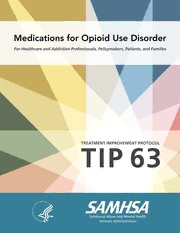
TIP 63: Medications for Opioid Use Disorder: For Healthcare and Addiction Professionals, Policymakers, Patients, and Families (2019) PDF
Preview TIP 63: Medications for Opioid Use Disorder: For Healthcare and Addiction Professionals, Policymakers, Patients, and Families (2019)
Medications for Opioid Use Disorder For Healthcare and Addiction Professionals, Policymakers, Patients, and Families TREATMENT IMPROVEMENT PROTOCOL T I P 6 3 Please share your thoughts about this publication by completing a brief online survey at: https://www.surveymonkey.com/r/KAPPFS The survey takes about 7 minutes to complete and is anonymous. Your feedback will help SAMHSA develop future products. TIP 63 MEDICATIONS FOR OPIOID USE DISORDER Treatment Improvement Protocol 63 For Healthcare and Addiction Professionals, Policymakers, Patients, and Families This TIP reviews three Food and Drug Administration-approved medications for opioid use disorder treatment—methadone, naltrexone, and buprenorphine—and the other strategies and services needed to support people in recovery. TIP Navigation Executive Summary For healthcare and addiction professionals, policymakers, patients, and families Part 1: I ntroduction to Medications for Opioid Use Disorder Treatment For healthcare and addiction professionals, policymakers, patients, and families Part 2: A ddressing Opioid Use Disorder in General Medical Settings For healthcare professionals Part 3: P harmacotherapy for Opioid Use Disorder For healthcare professionals Part 4: P artnering Addiction Treatment Counselors With Clients and Healthcare Professionals For healthcare and addiction professionals Part 5: R esources Related to Medications for Opioid Use Disorder For healthcare and addiction professionals, policymakers, patients, and families TIP 63 MEDICATIONS FOR OPIOID USE DISORDER Contents EXECUTIVE SUMMARY Foreword ..............................................................ES-iii Introduction ........................................................... ES-1 Overall Key Messages .................................................. ES-1 Content Overview ..................................................... ES-3 Notes .................................................................. ES-6 TIP Development Participants .......................................... ES-8 Publication Information ............................................... ES-12 PART 1: AN INTRODUCTION TO MEDICATIONS FOR THE TREATMENT OF OPIOID USE DISORDER The Approach to OUD Care .............................................1-1 Overview of Medications for OUD ......................................1-3 Duration of Treatment With OUD Medication ...........................1-8 Treatment Settings .....................................................1-9 Challenges to Expanding Access to OUD Medication ....................1-9 Resources ..............................................................1-10 Notes .................................................................. 1-11 PART 2: ADDRESSING OPIOID USE DISORDER IN GENERAL MEDICAL SETTINGS Scope of the Problem ...................................................2-1 Screening ...............................................................2-1 Assessment .............................................................2-8 Treatment Planning or Referral ........................................ 2-17 Resources ..............................................................2-28 Appendix ..............................................................2-32 Notes ..................................................................2-39 ii MEDICATIONS FOR OPIOID USE DISORDER TIP 63 PART 3: PHARMACOTHERAPY FOR OPIOID USE DISORDER Pharmacotherapy for Opioid Use Disorder ..............................3-1 Chapter 3A: Overview of Pharmacotherapy for Opioid Use Disorder ....3-5 Chapter 3B: Methadone ................................................ 3-15 Chapter 3C: Naltrexone ................................................3-35 Chapter 3D: Buprenorphine ............................................3-49 Chapter 3E: Medical Management Strategies for Patients Taking OUD Medications in Ofce-Based Settings ......................3-79 Chapter 3F: Medical Management of Patients Taking OUD Medications in Hospital Settings .......................................3-99 PART 4: PARTNERING ADDICTION TREATMENT COUNSELORS WITH CLIENTS AND HEALTHCARE PROFESSIONALS Overview and Context ..................................................4-1 Quick Guide to Medications ............................................ 4-12 Counselor–Prescriber Communications ................................4-18 Creation of a Supportive Counseling Experience .......................4-20 Other Common Counseling Concerns ..................................4-34 Notes ..................................................................4-37 PART 5: RESOURCES RELATED TO MEDICATIONS FOR OPIOID USE DISORDER General Resources ......................................................5-1 Resources for Counselors and Peer Providers ..........................5-10 Resources for Clients and Families ..................................... 5-11 Provider Tools and Sample Forms ...................................... 5-17 Glossary of TIP Terminology ...........................................5-57 Notes ..................................................................5-60 iii This page intentionally left blank. TIP 63 MEDICATIONS FOR OPIOID USE DISORDER Executive Summary For Healthcare and Addiction Professionals, Policymakers, Patients, and Families The Executive Summary of this Treatment Improvement Protocol provides an overview on the use of the three Food and Drug Administration-approved medications used to treat opioid use disorder—methadone, naltrexone, and buprenorphine—and the other strategies and services needed to support recovery. TIP Navigation Executive Summary For healthcare and addiction professionals, policymakers, patients, and families Part 1: I ntroduction to Medications for Opioid Use Disorder Treatment For healthcare and addiction professionals, policymakers, patients, and families Part 2: A ddressing Opioid Use Disorder in General Medical Settings For healthcare professionals Part 3: P harmacotherapy for Opioid Use Disorder For healthcare professionals Part 4: P artnering Addiction Treatment Counselors With Clients and Healthcare Professionals For healthcare and addiction professionals Part 5: R esources Related to Medications for Opioid Use Disorder For healthcare and addiction professionals, policymakers, patients, and families Substance Abuse and Mental Health Services Administration TIP 63 MEDICATIONS FOR OPIOID USE DISORDER—Executive Summary EXECUTIVE SUMMARY Foreword ..............................................................ES-iii Introduction ........................................................... ES-1 Overall Key Messages .................................................. ES-1 Content Overview ..................................................... ES-3 Notes .................................................................. ES-6 TIP Development Participants .......................................... ES-8 Publication Information ............................................... ES-12 ES-ii MEDICATIONS FOR OPIOID USE DISORDER—Executive Summary TIP 63 Foreword The Substance Abuse and Mental Health Services Administration (SAMHSA) is the U.S. Department of Health and Human Services agency that leads public health efforts to advance the behavioral health of the nation. SAMHSA’s mission is to reduce the impact of substance abuse and mental illness on America’s communities. The Treatment Improvement Protocol (TIP) series fulflls SAMHSA’s mission by providing science- based best-practice guidance to the behavioral health feld. TIPs refect careful consideration of all relevant clinical and health service research, demonstrated experience, and implementation require- ments. Select nonfederal clinical researchers, service providers, program administrators, and patient advocates comprising each TIP’s consensus panel discuss these factors, offering input on the TIP’s specifc topic in their areas of expertise to reach consensus on best practices. Field reviewers then assess draft content. The talent, dedication, and hard work that TIP panelists and reviewers bring to this highly participatory process have helped bridge the gap between the promise of research and the needs of practicing clinicians and administrators to serve, in the most scientifcally sound and effective ways, people in need of behavioral health services. We are grateful to all who have joined with us to contribute to advances in the behavioral health feld. Elinore F. McCance-Katz, M.D., Ph.D. Assistant Secretary for Mental Health and Substance Use SAMHSA ES-iii This page intentionally left blank.
